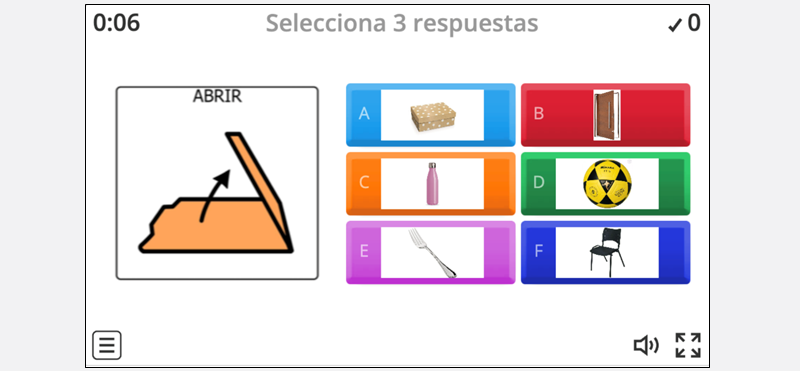Abrir/To Open
WAYS WE CAN USE THE WORD
TO INQUIRE e.g. ¿A qué hora se abre la tienda? (At what time does the store open?)
TO SHARE INFORMATION e.g. Necesito abrir la ventana porque hace mucho calor en la habitación. (I need to open the window because it’s very hot in the room.)
TO ASK FOR HELP e.g., Por favor ayúdame a abrir el frasco. (Please help me open the jar.)
CONJUGATIONS FOR PRESENT AND PAST
|
SUBJECT |
PRESENT |
PAST |
|
I |
abro |
abrí |
|
You |
abres |
abriste |
|
He/She/You (informal) |
abre |
abrió |
|
We |
abrimos |
abrimos |
|
They/ You All |
abren |
abrieron |
For specific questions or more ideas regarding this core word activity sheet, please contact Sofia Ortiz-Blandon @ fortiz1@mail.sfsu.edu. Thank you!
Snack/mealtimes: Adults can instruct students to open their backpacks and open their lunch boxes e.g., abre tu mochila y abre tu lonchera. (Open your backpack and open your lunchbox). At the table ask students “¿Qué necesitas abrir para comer?” Students answers will vary from mouth, hands, lunch boxes etc.
Circle: Teachers can ask students what they can open in the classroom for example, windows, doors, cabinets etc. Have students find these words on their AAC devices.
Mindful Breathing: Adults can ask students to first close their eyes open their mouths and take three deep breaths. Tell the students to notice their mouths opening with each breath they take. At the end tell them to open their eyes. “Cierra los ojos y abre la boca para respirar profundamente tres veces.”
Toys and Games: Adults can instruct students to open their toy boxes e.g., Abre la caja de juguetes. If Russian Nesting Dolls or something similar are available have students open the toys.
Recess: Adults can instruct students to open the equipment box where they store outdoor toys such as balls and jump ropes. E.g., Abre la caja del equipo y agarra los juguetes.
Here is a suggested book on YouTube that can assist in teaching the core word:
- Cuento infantil: POR FAVOR NO ABRIR ESTE LIBRO !!
- Find books in the classroom/library that have pop-up and lift-up tab features. Before reading the book to the students, explain that they will take turns coming up to the teacher to “abrir” (open) the tabs.
Regalos Sorpresa de la Bolsa Mágica de Plim Plim. In this video Plim Plim and friends open presents from a magic bag.
Object Exploration: gather a variety of objects with different types of closures such as boxes, jars, envelopes, zippers, and buttons. Demonstrate how to “abrir” each item while saying the word aloud. Encourage the students to imitate the action and repeat the word.
Sensory Play: set up a sensory bin or table with various containers filled with different materials such as sand, rice, or water. Label each container with the word “abrir.” Encourage the children to explore the containers by opening them, feeling the contents, and use their devices to describe their observations.
- Super Simple Songs ~ Abre Cierra ~ Canciones Infantiles
- Plim Plim ~ Abrir Cerrar ~ Canciones Infantiles
- Abrir y cerrar cancion infantil | Los Amiguitos Canciones Infantiles
- Abre Cierra | Canciones Infantiles | Super Simple Español
- Abre Cierra #2 | Canciones Infantiles
- Abre Cierra #3 Invitando A Bebé Tiburón | Canciones Infantiles
Treasure box: prepare a box filled with small objects or pictures. Write the word abrir on the box. Have the students take turn selecting an item from the box and describing it using the word abrir.
Lemonade stand: in the dramatic play area of the classroom students can open a lemonade stand. Tell the students “Vamos a abrir un puesto de limonada.”
Craft Activities: Students/Adults can engage in a craft project that involve opening and closing actions. For example, make big mouth animals and monsters.
Science Activity: Go outside and find some pinecones. Explain to the students that “Cuando está seco fuera las piñas abren pero cuando llueve las piñas se cierran. (When it’s dry outside the pinecones open. But when it’s raining outside the pinecones close.) This website offers a lot of information about the science of pinecones.
Wordwall conjugation game: helps students to conjugate abrir.

Wordwall abrir game: The object of this game is to select three objects that you can “abrir” (open).

WORD WALL: Create a WordWall and add ‘abrir’ to the list.

READING and the Word Wall: Sound out the letters together. Have the students find the word on the AAC system.
WRITING and the Word Wall: Using a pencil or alternative pencil, have students try to type the word on the keyboard or write the word together.